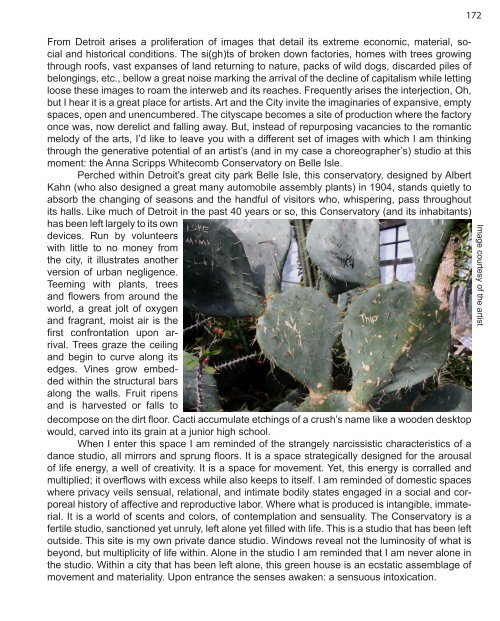Detroit Research Volume 1
You also want an ePaper? Increase the reach of your titles
YUMPU automatically turns print PDFs into web optimized ePapers that Google loves.
172<br />
From <strong>Detroit</strong> arises a proliferation of images that detail its extreme economic, material, social<br />
and historical conditions. The si(gh)ts of broken down factories, homes with trees growing<br />
through roofs, vast expanses of land returning to nature, packs of wild dogs, discarded piles of<br />
belongings, etc., bellow a great noise marking the arrival of the decline of capitalism while letting<br />
loose these images to roam the interweb and its reaches. Frequently arises the interjection, Oh,<br />
but I hear it is a great place for artists. Art and the City invite the imaginaries of expansive, empty<br />
spaces, open and unencumbered. The cityscape becomes a site of production where the factory<br />
once was, now derelict and falling away. But, instead of repurposing vacancies to the romantic<br />
melody of the arts, I’d like to leave you with a different set of images with which I am thinking<br />
through the generative potential of an artist’s (and in my case a choreographer’s) studio at this<br />
moment: the Anna Scripps Whitecomb Conservatory on Belle Isle.<br />
Perched within <strong>Detroit</strong>’s great city park Belle Isle, this conservatory, designed by Albert<br />
Kahn (who also designed a great many automobile assembly plants) in 1904, stands quietly to<br />
absorb the changing of seasons and the handful of visitors who, whispering, pass throughout<br />
its halls. Like much of <strong>Detroit</strong> in the past 40 years or so, this Conservatory (and its inhabitants)<br />
has been left largely to its own<br />
devices. Run by volunteers<br />
with little to no money from<br />
the city, it illustrates another<br />
version of urban negligence.<br />
Teeming with plants, trees<br />
and flowers from around the<br />
world, a great jolt of oxygen<br />
and fragrant, moist air is the<br />
first confrontation upon arrival.<br />
Trees graze the ceiling<br />
and begin to curve along its<br />
edges. Vines grow embedded<br />
within the structural bars<br />
along the walls. Fruit ripens<br />
and is harvested or falls to<br />
decompose on the dirt floor. Cacti accumulate etchings of a crush’s name like a wooden desktop<br />
would, carved into its grain at a junior high school.<br />
When I enter this space I am reminded of the strangely narcissistic characteristics of a<br />
dance studio, all mirrors and sprung floors. It is a space strategically designed for the arousal<br />
of life energy, a well of creativity. It is a space for movement. Yet, this energy is corralled and<br />
multiplied; it overflows with excess while also keeps to itself. I am reminded of domestic spaces<br />
where privacy veils sensual, relational, and intimate bodily states engaged in a social and corporeal<br />
history of affective and reproductive labor. Where what is produced is intangible, immaterial.<br />
It is a world of scents and colors, of contemplation and sensuality. The Conservatory is a<br />
fertile studio, sanctioned yet unruly, left alone yet filled with life. This is a studio that has been left<br />
outside. This site is my own private dance studio. Windows reveal not the luminosity of what is<br />
beyond, but multiplicity of life within. Alone in the studio I am reminded that I am never alone in<br />
the studio. Within a city that has been left alone, this green house is an ecstatic assemblage of<br />
movement and materiality. Upon entrance the senses awaken: a sensuous intoxication.<br />
Image courtesy of the artist





